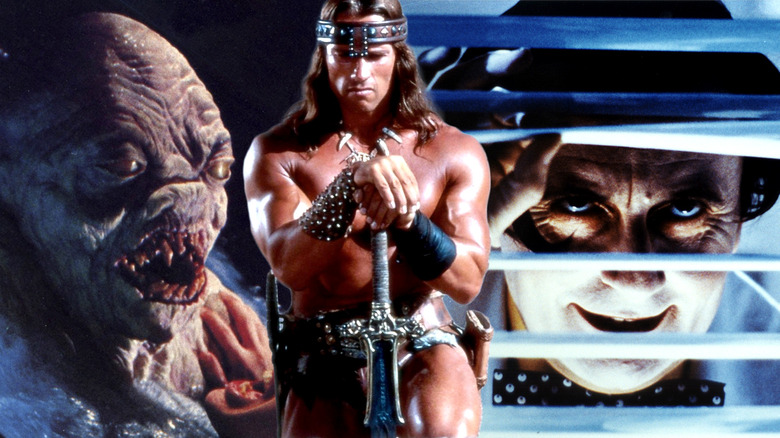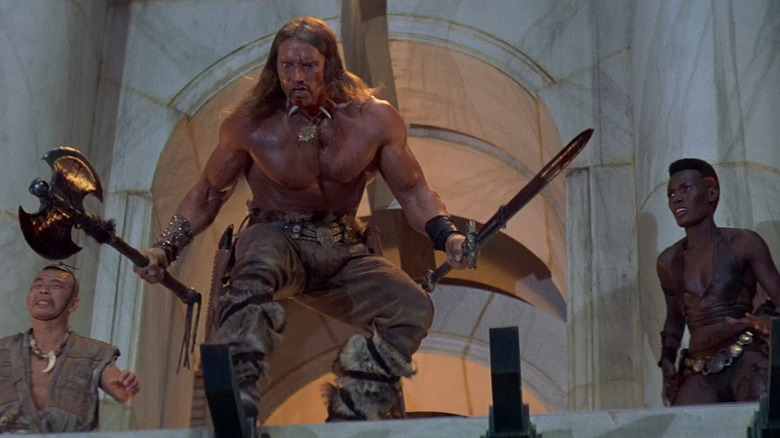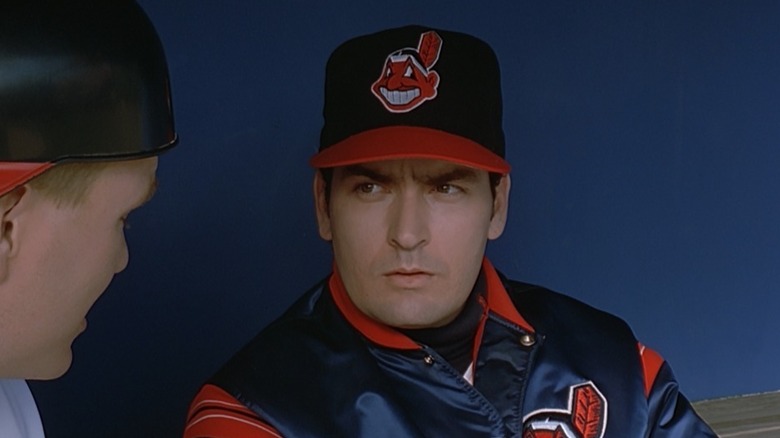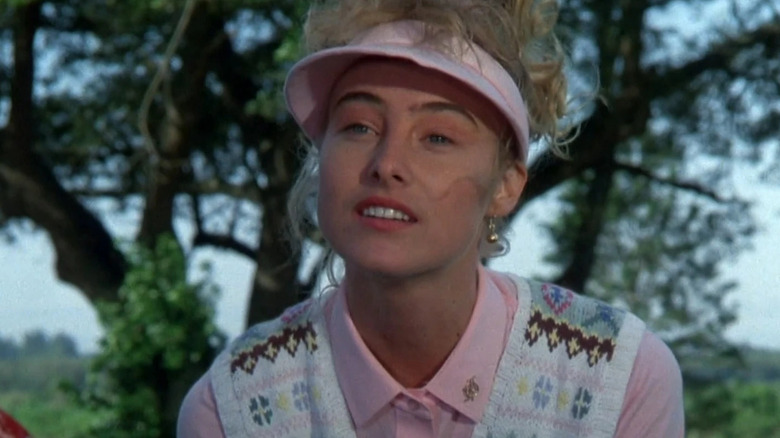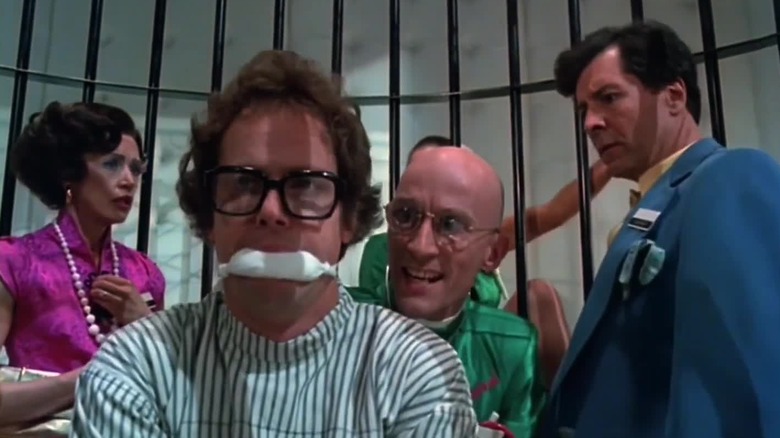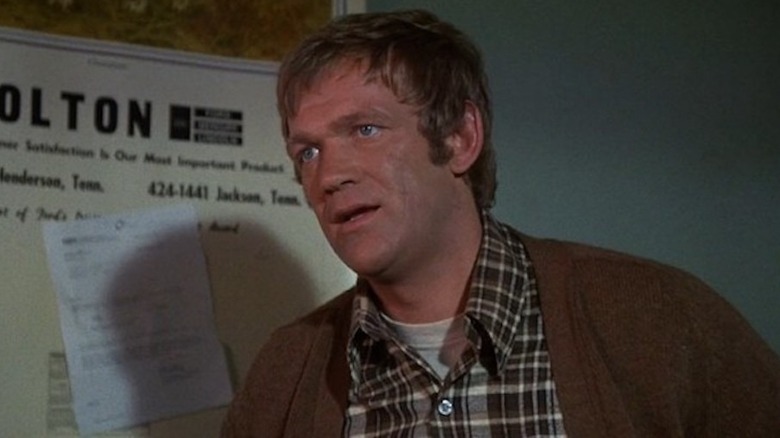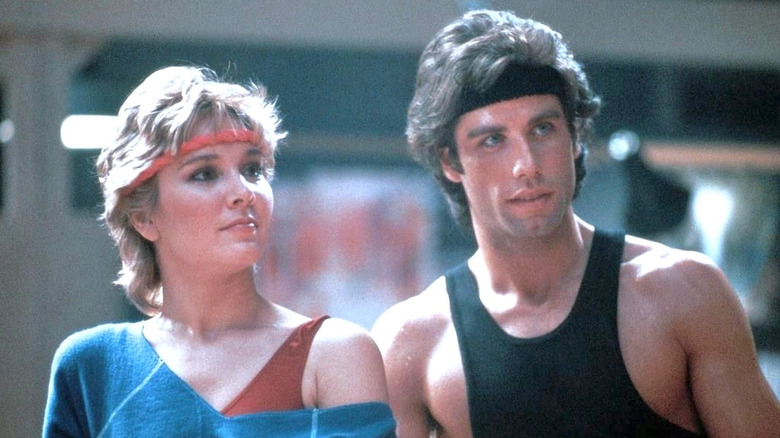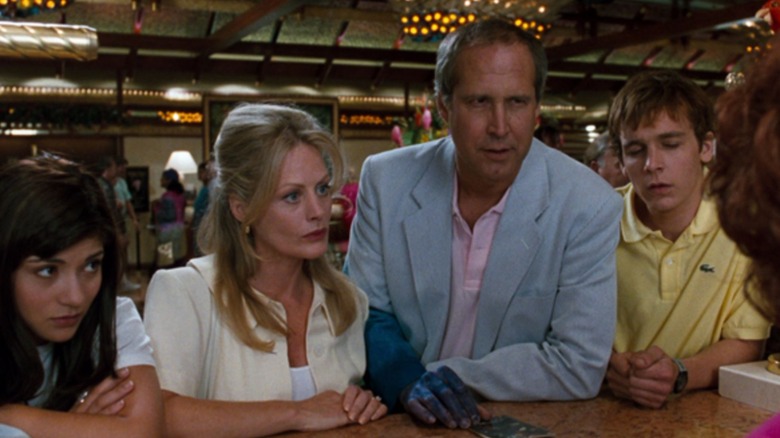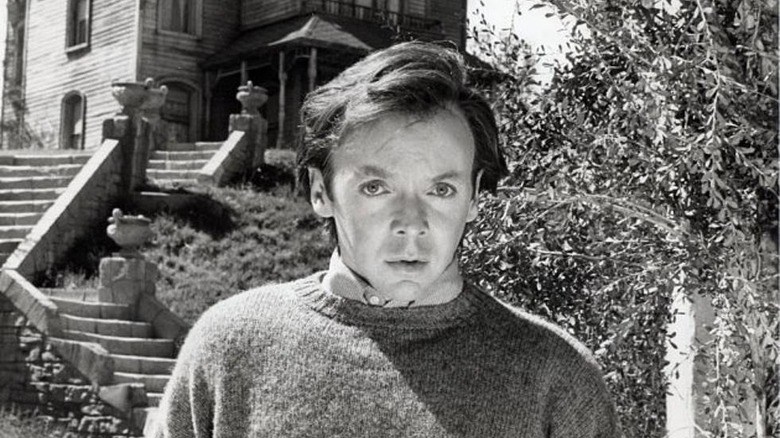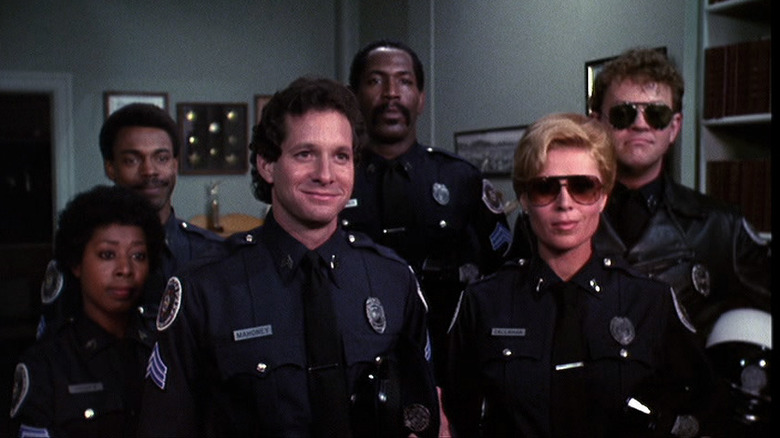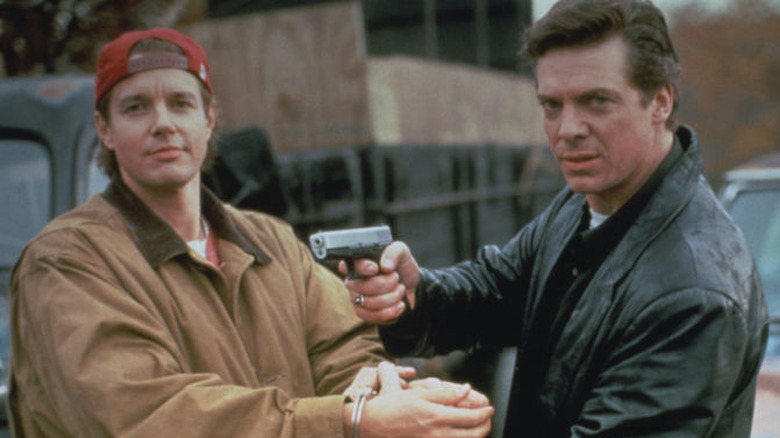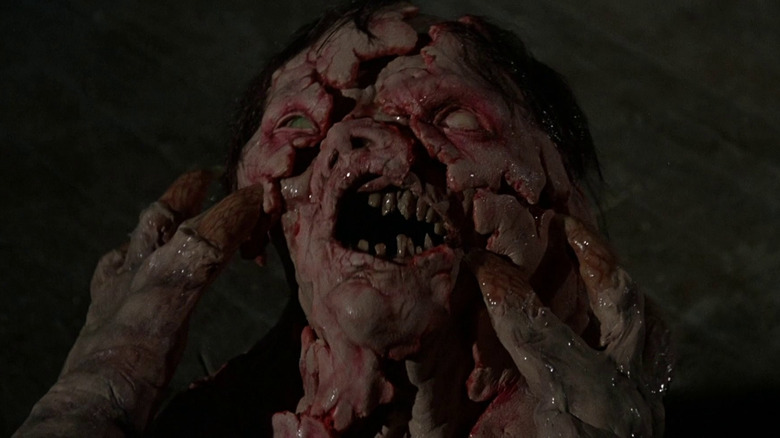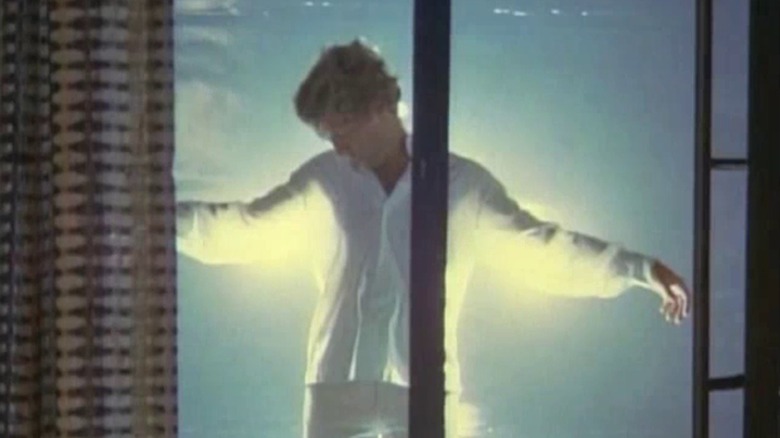R-Rated Movies That Went PG With The Sequel
Short for restricted, the R-rating can be handed out to films for a variety of reasons. Graphic violence, sexual content, excessive profanity, or even mature themes are enough to get the R. Nevertheless, the label has frequently been given to some of the most beloved and iconic films ever made, across just about every genre. But when an R-rated movie finds a measure of success, and the studio wants to parlay that hit into a series of sequels, that rating can suddenly come under scrutiny.
Looking for an even bigger hit the second time around, they may want to expand their audience, and that can lead them to ditch the R-rating. But while a fair amount of movies settle on a PG-13 rating — somewhat edgy but not entirely out of reach for teens and kids — there are some sequels that go further, following an R-rated classic with a purely PG sequel. But to do it likely means toning down the violence, eliminating the swear words, and taking out sex and drugs. Unfortunately, while some have managed to find some success, most have fallen flat on their face. In fact, you might even be surprised at which famous films ditched the "R" and went family-friendly. From classic comedies to seminal horror movies, we're going behind the curtain to explore R-rated movies that went PG for the sequel.
Conan the Destroyer
Based on a series of pulp fantasy novels by author Robert E. Howard, "Conan the Barbarian" was also the first movie to make Austrian-born bodybuilder-turned-actor Arnold Schwarzenegger a bonafide action hero. The film put him into the role of a mighty warrior whose parents had been slaughtered in his youth by a diabolical warlord named Thulsa Doom (James Earl Jones). Years later, Conan goes on an epic quest for revenge, carving a swath of death and destruction across the land in search of the villain who'd wronged him. Packed with the same kinds of gruesome sword-slashing violence and gratuitous nudity that adult fans of fantasy had come to expect from the genre, the film earned its R-rating but also became an unexpected box office hit.
With a series of novels to adapt, "Conan the Destroyer" arrived just two years later, which brought back Arnold Schwarzenegger as the sword-wielding barbarian warrior. What it didn't bring back, however, was its R-rating. Hoping to attract a broader audience of moviegoers, the sequel ditched much of the blood and gore along with the half-naked damsels in distress and found itself earning a family-friendly PG. Unfortunately, it was only a drawback, and the film sputtered at the ticket counter, doing less than half of its predecessor. If only they had waited just a little longer, they could have used the PG-13 rating, which was introduced just 48 hours after the film's release.
Major League II
Not just a great baseball movie, but one of the best sports movies ever made, "Major League" is an uproariously funny all-time '80s classic. It centers on the woeful Cleveland Indians, whose new owner wants to move the team, but can only do it if they have yet another last-place finish. But after filling the roster with losers to ensure another woeful season, the underdog team coalesces to beat the odds and make it to the playoffs.
Wild, crass, and crude, "Major League" earned itself an R-rating for plenty of profanity and moments that were too hot for family audiences. After becoming an unexpected hit, a sequel was quickly ordered, and much of the cast returned, including Charlie Sheen, Tom Berenger, and Corbin Bernsen. What didn't return was the film's edgy humor, adult situations, and its clear-cut R-rating. Now coming in at a firm PG, "Major League II" felt more like a sanitized copycat than a legitimate sequel, and audiences took notice. No longer appealing to the moviegoers who'd lapped up the original, and not attracting the family audience it might have been hoping for, it couldn't match its predecessor at the box office.
A few years later, the follow-up "Major League III: Back to the Minors" wised up and landed with a solid PG-13. Unfortunately, it was too little too late, as almost none of the original cast returned, and it wound up being a sad, low end to the trilogy.
Caddyshack II
Catapulting to fame on "Saturday Night Live" the decade before, actors Chevy Chase and Bill Murray joined Rodney Dangerfield and Ted Knight for "Caddyshack" in 1980. The film chronicles the lives of a group of wealthy, pretentious, upper-crust clientele at the exclusive Bushwood Country Club. Groundskeeper Carl Spackler (Murray) deals with a persistent gopher, golfer Ty Webb (Chase) becomes obsessed with mastering his game, and crotchety Al Czervik (Knight) causes problems for a college-bound teen looking for a scholarship. It all adds up to one of the most side-splitting, madcap comedies of the decade, and the vulgar humor was a big part of its appeal.
So in 1988, when "Caddyshack II" hit theaters, fans of the first film probably looked at it cockeyed, wondering why it was rated PG. Gone were all the crude, envelope-pushing jokes that made the first film so funny, and out were most of the cast too, with Jackie Mason, Robert Stack, Dyan Cannon, and Randy Quaid subbed in. The plot this time revolves around a new player at the club who resents his highfalutin fellow members and sets out to buy Bushwood and turn it into a family fun park.
Now PG, there's little to laugh at this time around as the film suffers from its attempt to find a bigger audience. In the end, it was more than a mere box office bust: it's remembered as one of the worst sequels in comedy history.
Shock Treatment
Originating as a stage production, the 1975 film "The Rocky Horror Picture Show" has grown such a passionate fan following that showings continue to this day, often featuring live performances and inviting audience participation. It was created by Richard O'Brien, who co-stars as hunchbacked assistant Riff Raff to Tim Curry's Dr. Frank-N-Furter, a cross-dressing scientist who is determined to create the perfect man. The film sees his mansion gatecrashed by Brad and Janet, a young couple whose car breaks down, and hilarity ensues when the pair of ordinary suburbanites meet Frank-N-Furter and a cast of eccentric oddballs.
Equal parts dark comedy and manic musical, "The Rocky Horror Picture Show" was rated R for some mild sex scenes and brief nudity, not to mention its sometimes disturbing (and murderous) themes. But less known is the film's sequel, 1981's "Shock Treatment," which promotes Riff Raff to the lead role. The film flips the script and centers on a now-married Brad and Janet, who live in a community that is one giant television studio, whose entire population is taking part in what we'd now call a reality TV show.
An equally manic satire as lively as "The Rocky Horror Picture Show," it didn't intentionally tone things down — the story just didn't call for the R-rating of the previous film. Neither beloved nor reviled, it's today just a footnote in "Rocky Horror" lore, mostly notable for its prophetic look at reality television.
Walking Tall Part 2
Audiences today might remember "Walking Tall" best from the 2004 film starring Dwayne "The Rock" Johnson, but that film was actually a remake of a 1973 film of the same name. It starred Joe Don Baker as Sheriff Buford Pusser, who moves back to his hometown in Tennessee and discovers it overrun by criminal thugs and rampant corruption. After winning the job of the town's sheriff, Pusser acts as a one-man army in an attempt to clean up the town. Smashing thugs with baseball bats and popping off crooks with a muzzle full of hot lead, it deserved its R-rating.
Just two years later, though, when the time came for a sequel, all the brutality and violence were tossed aside to help "Walking Tall Part 2" get a PG rating. Though Pusser still wields a baseball bat and a gun, his mission to take down a gang of moonshine runners — and get revenge for the murder of his wife — has a decidedly more tame tone. Though the movie wasn't nearly as big a hit, it did get a third sequel, which returned the series to its original R-rating, but swapped out Baker for new star Bo Svenson. Even the Rock's remake decades later was smart enough to go for a hard R, as were its two direct-to-DVD sequels starring Kevin Sorbo, though doing so didn't help any of them become big hits like the original.
Staying Alive
The movie that made John Travolta a superstar, "Saturday Night Fever" arrived at the height of the disco craze. It introduced Travolta as Tony Manero, a fleet-footed young New Yorker who wants to escape his tough life in a hardscrabble neighborhood and becomes a hit on the dance floor. A risque film with lots of steamy sex scenes, "Saturday Night Fever" was rated R for profanity, nudity, and an assault that definitely warrants an audience warning. But it was also a massive hit, earning nearly $100 million and becoming one of the hottest films of the decade.
With a big success on their hands, naturally, a sequel was in order, and it came in 1983 in the form of "Staying Alive." Travolta returned as Tony Manero, and "Rocky" star Sylvester Stallone stepped in to direct, as the follow-up saw the young dancer try to break into the biggest stage of all: Broadway. This time, though, Manero is joined by Cynthia Rhodes, Finola Hughes, and Sylvester's brother Frank. A far less interesting story, it struggled to capture moviegoers' attention, and going PG didn't help, erasing much of the original film's sex appeal.
Though it's hard to say if the lighter rating had any impact, "Staying Alive" couldn't match the first movie's take at the ticket counter. It was also slaughtered by critics, with many accusing it of being a soulless cash grab that was without any of the excitement of "Saturday Night Fever."
Vegas Vacation
"Caddyshack" wasn't the only R-rated Chevy Chase classic to come back with a PG-rated sequel. In 1983 he starred in the raunchy comedy "National Lampoon's Vacation." In the film, Chase plays Clark Griswold, the hapless husband who promises to take his family on vacation to the fictional "Walley World" theme park but gets derailed by one disaster after another along the way. This includes accidentally killing their Aunt Edna's dog, crashing a car, getting stranded in Monument Valley, and getting swindled by a greedy mechanic.
Thanks to some crass jokes, nudity, and scenes showing minors using drugs, "National Lampoon's Vacation" was definitely for adults, but its sequels skirted the harsher rating thanks to the introduction of PG-13 just a year after its release. In 1997, a fourth entry in the series arrived, and perhaps owed to changing times — coming almost a decade after the last entry "Christmas Vacation" — the film goes for a more family-friendly PG. Chase returns to lead "Vegas Vacation" once again playing Clark Griswold. But with watered-down jokes, the film just feels like a pale imitation, and audiences responded accordingly. Drawing just $36 million in theaters, it's the lowest-grossing entry in the series, and outside of the abominable spin-off "Christmas Vacation 2," it's also the worst-reviewed.
Bates Motel
"Psycho" arrived in 1960, from the master of suspense Alfred Hitchcock. The film at first centers on Marion Crane (Janet Leigh), who stops at a roadside motel run by Norman Bates (Anthony Perkins). A troubled young man, we ultimately learn that Bates is actually a knife-wielding serial killer. Surprisingly, "Psycho" received a follow-up 23 years later, after the slasher genre had emerged late the previous decade. "Psycho II" and "Psycho III" were both R-rated sequels, and though they don't quite live up to the greatness of the original, they have their own unique appeal.
In 1987, however, someone had the bright idea to bring "Psycho" to television, in a TV film titled "Bates Motel." Initially developed with the hopes of sparking an ongoing TV series — more than 25 years before A&E would bring the similarly titled drama series to air — "Bates Motel" wound up a standalone movie that is somehow appropriate for all ages. It's set in the aftermath of the first film, when Norman Bates is locked up for murder, and centers on Alex West (Bud Cort), another disturbed man who now runs the motel.
With barely any violence and nothing as disturbing as what was found even in the original film some three decades before, the TV sequel was a dismal failure. They'd learn their lesson, though, because the next TV movie was 1990's "Psycho IV: the Beginning" which aired on Showtime and returned to the series' more gruesome roots and its original R rating.
Police Academy 3: Back in Training
The '80s were a decade practically built off the back of tawdry, tasteless comedy movies, like "Porky's" and even "Caddyshack." But few did it with as much flare as 1984's "Police Academy," which fused the wild antics of a college fraternity with the brotherhood in blue. Starring Steve Guttenberg, Michael Winslow, Kim Cattrall, and a collection of comic geniuses, the film revolves around the day-to-day lives of a group of inept, goofball police recruits in training. Though it lacks graphic violence and is even surprisingly light on profanity, the film's liberal use of nudity and crass jokes are what made it so much fun — and what earned it an R rating.
Landing to a whopping $81 million "Police Academy" kicked off a long-running series, and the sequels immediately softened the humor to PG-13 territory. But by the time the third entry came around, "Police Academy 3: Back in Training," it had fallen all the way to a family-friendly PG rating. Gone were the sex jokes and nudity, replaced with much more childish grade school humor and slapstick gags, effectively sucking out every ounce of what made the first film great.
Despite its more saccharine content, though, the threequel still managed a respectable box office tally, and four — yes four — more sequels followed, as well as a short-lived TV series in 1997, all family-friendly.
Another Midnight Run
In addition to crass comedies, buddy comedy capers were a booming genre in the '80s, with iconic entries like "48 Hrs." and "Lethal Weapon" leading the way. But one of the best action comedies of all time remains "Midnight Run," the 1988 film that paired Robert De Niro with comedian Charles Grodin. The story sees bounty hunter Jack Walsh (De Niro) snatching up bail-skipper Jonathan Mardukas (Grodin), who's stolen millions from a criminal kingpin. While Walsh wants to get Mardukas back to make his reward, intrepid FBI agent Mosely (Yaphet Kotto) wants him to turn state witness. At the same time, they're being trailed by gangland thugs who want Mardukas dead.
An R-rated '80s action flick, "Midnight Run" became the unlikely subject for a string of TV movie sequels. This time, Walsh is played by future Shooter McGavin actor Christopher McDonald, who finds himself tracking down another ex-con for a big payday. Airing in 1994, the film is technically unrated, but it has all the trappings of a PG sequel, lacking the wit and cleverness of De Niro and Grodin, while the action is significantly curtailed for network TV broadcasting. Sure, there are some car chases and shootouts, but throw in the low TV budget with cheap, watered-down action, and it comes across more like a screwball comedy than a great action movie.
Still, it must have entertained somebody, because it received two more TV sequels: "Midnight Runaround" and "Midnight Run for Your Life."
Amityville 3-D
Based on a book that was supposedly based on real events, "The Amityville Horror" shocked audiences in the summer of 1979. A grisly ghost story, it sees newlyweds George and Kathy Lutz move into a new home only to be menaced by an evil presence that resides there. As it turns out, the home was recently the site of a gruesome mass murder, perpetrated by a bloodthirsty killer who murdered his entire family. Blood-curdling imagery permeates this unnerving horror story, which seems to have garnered its R rating thanks to its horrific tone, more than any graphic violence, sex, or profanity.
As was the order of the day, of course, "The Amityville Horror" spawned a nearly inexhaustible supply of sequels, each more ridiculous than the last. But it's the third sequel that gets an entry on our list inexplicably opted for a PG rating. How does a terrifying movie like "The Amityville Horror" tone itself down to get a lighter certificate from the MPAA? Well, for starters, it goes 3D. Released in 1983, "Amityville 3-D" goes almost totally bloodless, centering this time on a skeptical journalist hoping to prove that the Amityville house isn't haunted at all.
Appealing to a broader audience, the film has little in the way of scares at all, instead opting for a more ordinary — if spooky — drama. In the end, it was a major disappointment. The franchise ditched the notion of PG immediately and returned to R ratings for its subsequent six sequels.
Look What's Happened to Rosemary's Baby
We're not quite sure why so many iconic horror movies felt the best way to make a sequel was to turn off the scares and make it family-friendly, but there's at least one more that did just that. "Rosemary's Baby" is a landmark horror film from 1968, written and directed by Roman Polanski, based on a novel about a pregnant young woman (Mia Farrow in the film) who believes her neighbors may be involved in a Satanic cult. But what's even more horrifying is that they may be planning to use her unborn baby as a human sacrifice. Truly chilling, the R-rated classic included a number of shocking scenes and extremely mature themes.
Still, the original film garnered critical acclaim and earned Ruth Gordon an Academy Award for best supporting actress, yet despite its success, its sequel — a made-for-TV affair in 1976 — dropped everything that made the film great. The story picks up years later when the 8-year-old son of Rosemary is abducted from his bed, and 20 years later, he becomes the target of the spirit of Satan himself.
Removing the haunting imagery and almost all the scares, the embarrassingly titled "Look What's Happened to Rosemary's Baby" never pushes boundaries and fails to shock or disturb. It all adds up to a dull, tedious, and uninspired follow-up that's only shocking in its tepidness.
